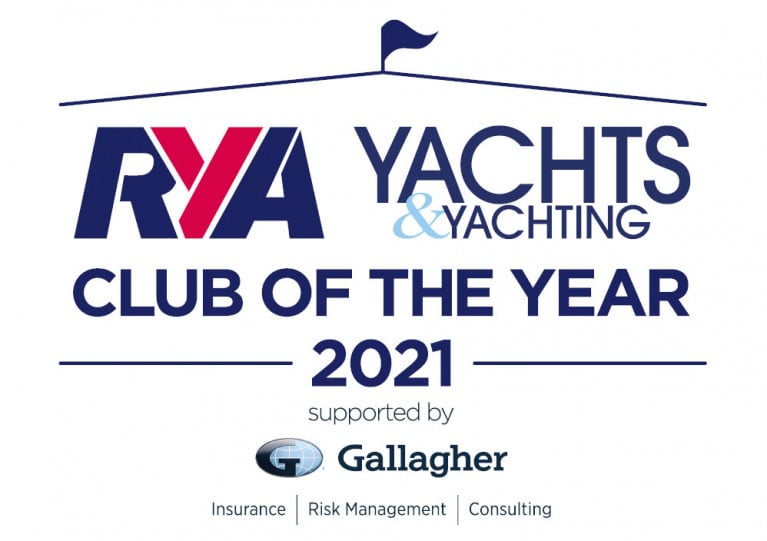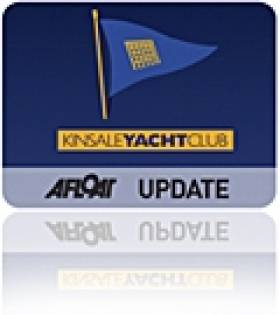Displaying items by tag: Club of the Year
Strangford Sailing Club Selected as Finalist for RYA/Yachts & Yachting Club of the Year 2021
Strangford Sailing Club has been named among the finalists for RYA and Yachts & Yachting Club of the Year 2021.
Ten clubs across the UK have been selected by the RYA Awards Panel, with online voting now open.
The Co Down club is the only Northern Ireland finalist this year for the annual gong, which saw Strangford Lough Yacht Club and East Antrim Boat Club in the running this time last year.
The RYA and Yachts & Yachting Club of the Year award, supported by Gallagher, recognises the outstanding achievement of sailing clubs across the UK and promotes the hard work and dedication that goes into running a successful club.
Voting closes on Monday 25 January, and the award presentations and overall winner announcement will be made at the RYA Virtual Dinghy Show on 27-28 February.
Call For NI Clubs To Apply For RYA Club Of The Year Gong
Applications are now open for the 2021 RYA and Yachts & Yachting Club of the Year award supported by Gallagher.
The annual event celebrates the outstanding achievement and promote the hard work of sailing clubs in England, Wales, Scotland and Northern Ireland.
Last year’s award saw two NI clubs — East Antrim Boat Club and Strangford Lough Yacht Club — as well as Prestwick Sailing Club in Scotland make the list of finalists.
All RYA-affiliated clubs across the UK are eligible to apply and the award panel will select a finalist for each of the 10 RYA regions, as well as two ‘wild card’ entries.
During the shortlisting stage, the panel will also provide five clubs with recognition for particular achievements in the following five areas:
- Heart of the community — new for 2021, a recognition for a club that has worked tirelessly to support their local community. This could be through the efforts of volunteers working within their local area for good causes, sharing club facilities with those in need or opening their club up to local community groups to get out on the water.
- Modern, innovative and forward thinking — recognition for a club that makes a break from traditional ways of running a club or delivering boating activity. This could be delivering different formats of training or racing to engage new participants, creating new membership models or embracing the use of modern communications.
- Sustainability — another new category with recognition for a club that has embraced sustainability and demonstrably reduced its own and/or its members impact on the environment through education, action or improved facilities.
- Inclusive and open to all — recognition for a club or project which has been impactful in developing participation amongst people with disabilities or from other under-represented or disadvantaged groups.
- Boosting membership — recognition for a club that has delivered the most impactful participation project, the outcomes of which are, attracting and retaining new participants and growing their membership.
All finalists go through to a public vote with the overall winner selected by RYA members, Yachts & Yachting readers and the judging panel.
‘It feels more important than ever to recognise the people who have worked tirelessly to ensure that others can continue to get out on the water safely’
The overall winner of the 2021 RYA and Yachts & Yachting Club of the Year will be announced at the RYA Dinghy Show scheduled for next February.
“The past few months have been hugely challenging for clubs, so it feels more important than ever to recognise the people who have worked tirelessly to ensure that others can continue to get out on the water safely and enjoy what they love doing,” said RYA director of sport development, Alistair Dickson.
Yachts & Yachting editor Georgie Corlett-Pitt added: “While recent months may have posed many unprecedented challenges for our clubs, they have also brought to the fore the spirit and resilience of the sailing community.
“This year more than ever we look forward to acknowledging those achievements with the RYA and Yachts & Yachting Club of the Year awards.”
Club applications close on Monday 21 September. For more information on the award and to complete an application form, visit the RYA website HERE.
Sailing Club of the Year Awards, A History of the Inter–Club Contest
#cluboftheyear – The Mitsubishi Motors "Sailing Club of the Year" for 2014 will be announced tonight. W M Nixon looks back on a unique inter-club contest with which he has been involved since its inception 35 years ago, and reflects on a challenge to the Royal Cork's position of historic significance as the oldest yacht club in the world.
Is the Royal Cork Yacht Club, descended directly from the Water Club of the Harbour of Cork with its establishment in 1720, really and truly the oldest yacht club in the world? The nautical blogosphere and its comments departments have been busy of late, as folk became exercised about the "new" discovery that the Squadron of the Neva, a potential rival claimant in Imperial Russia, was founded two years earlier in 1718.
We've been here before, thanks to the Mitsubishi Motors "Sailing Club of the Year". This informal contest, completely unique when it first appeared in 1979, has long since become an accepted part of Irish sailing. It has served several useful purposes in that it has more clearly analysed what it is that makes the best of Ireland's remarkably successful yacht and sailing clubs tick, it has given us a template for club development and fulfilment, and it has provided a complete record of an important part of Irish sailing history simply because we now have a list of the many winners going back 35 years.
It started in the weirdest way. Sean O'Shea, a good old-fashioned Dublin PR man, was in his car in a traffic jam outside an antique shop in the city centre in 1978, and while stopped he ran his eye over the items on display, which included a ship's wheel. It was quite some traffic jam, for by the time he was moving along again, his busy brain was developing the notion of using the old wheel as a trophy in sailing. When he'd finally reached his destination, he'd decided that it should be some sort of trophy for sailing which would have the unique feature of somehow being awarded to people who personally might not have actually won some sailing race or other.
In those distant days, all of Ireland's national newspapers (all three of them) carried weekly columns on sailing, acres of newsprint with regular photo usage. I wrote the one for the Irish Independent, so he cast a fly over me as to how this "awarding everyone" concept might best be done, for he could see PR opportunities for one of his client companies in it. We kicked some ideas around (in a classic Dublin pub of course, Sean was a connoisseur of Guinness) and somehow the notion – utterly crazy at the time - emerged of a Club of the Year contest.
Back in 1979, if there was such a contest anywhere else in the world, we didn't know of it. So I went home and bashed out the defining characteristics of a successful sailing club on the little Olivetti typewriter (I produced so much verbiage in those days that a new Olivetti every 18 months was an essential), and soon discovered that there was a lot more to the successful clubs than staging popular and stylish events and having members who won major championships.

The 1980 winner was Malahide YC, and the presentation was a two part ceremony, with the ship's wheel being presented aboard a ship in Dublin port, while the celebration took place in MYC's new clubhouse. Photo shows Frank Cormican (left) of original sponsors Coal Distributors, and MYC Commodore Peter Killen aboard the ship. Peter Killen became the Commodore of the Irish Cruising Club on February 14th 2014.
There was the requirement of having good and pro-active relations within the community of which they were part, which was an odd enough idea in 1979, when most clubs seemed aloof, or at the very least self-absorbed. There was of course the obvious requirement of encouraging newcomers to the sport, while having the good sense to know who would be worthwhile sailors and members, and who would not. There was the cultivation of good use of the media, limited and all as it was in those days. There was the need to foster junior development and sail training programmes for all ages. And most important of all, there was the need to have catered for your members' needs, to have brought them along with you in enthusiastic support of new projects, and to have maintained and developed that spirit of volunteerism within the membership which is the essence of the good Irish sailing club.
While "community" may be an over-used word these days, back in 1979 the idea of applying it to a yacht club was still a novel notion, but we decided we'd try to see how the concept of community manifested itself within the clubs which were emerging at the front line of this new informal contest. In the form in which the Club of the Year competition was to emerge after six years of growth, the system which proved to work best was when we simply included all the 120 clubs in Ireland in it – there was no need for any formal entry, as we reckoned the club staff of those days, most of them voluntary, had quite enough to be doing without having to fill out yet another lot of forms.
A small panel of adjudicators was established, and they only emerged (and even then only if they wished - some preferred to remain anonymous) at the award ceremony. The idea was to cover the country, but under the radar. The adjudicators were active in sailing, and between us we were directly engaged with virtually all of the clubs in the country in any one year. But this adjudication was not done on official visits. On the contrary, the idea that clubs would be aware that they were being assessed at any particular time was anathema to the central notion that it was the club's primary duty to serve their own membership, and you could do this best by managing to have a visit more or less unnoticed, as part of a crowd of participants in some sailing event, or as the attendance at a social gathering, or - sometimes best of all - simply under the guise of a visitor from another club hoping to enjoy the fraternal hospitality of the club being scrutinised. This was how it all gradually developed, but it took time for the requirements for a successful inter-club competition to emerge.
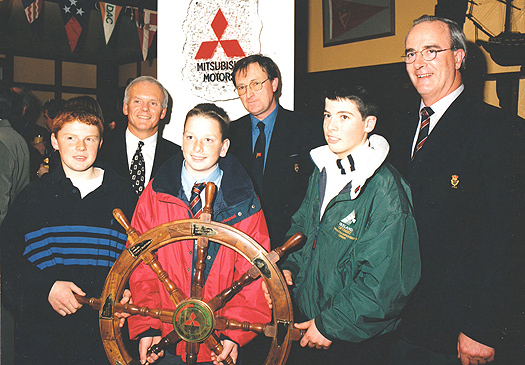
The ground-breaking presentation to the Royal Cork YC for 1992's great season. In the background are Eugene O'Reilly (Mitsubishi Motors) outgoing Admiral Kevin Lane, and incoming Admiral Anthony O'Leary. Twenty-one years down the line, how has it been going for the junior sailors in the foreground? Photo: Bob Bateman
Back in the late 1970s, Irish sailing was a much less vigorous creature than it subsequently became, and the affluence of the country was at a very low level. For the first few years, the sponsor, drawn from Sean O'Shea's decidedly eclectic portfolio, was a conglomerate in the coal importing business. In retrospect, that feels only marginally better than a tobacco company. But they wanted to give themselves a fresher image, we had the vehicle, and the show was on the road.
The first winners in 1979 were Wicklow Sailing Club, who had broadened their scope that year with a family cruising rally initiative. When you consider that in 1980 they inaugurated the Round Ireland Race, it gives you some notion of how quiet the sailing innovation scene was in the 1970s. Back then, the hottest show on the sea throughout the decade was the annual programme of the Irish Sea Offshore Racing Association, which at its peak attracted 107 boats to its annual season-long championship.
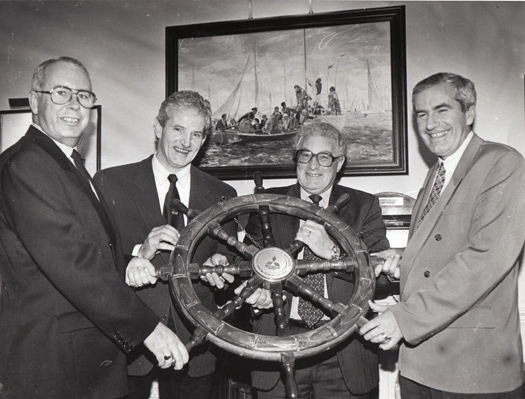
1993 saw the first dual award, to the National YC of Dun Laoghaire and the St Brendan Sailing Club of Dingle for the successful introduction of the Dun Laoghaire to Dingle Race. At the presentation were (left to right) Brian Barry (NYC Commodore), John O'Connor (Dingle commodore), Frank Keane, Chairman of Mitsubishi Motors, and Barry Rose. As Commodore of ICRA, Barry Rose was himself a winner in 2011 to honour Ireland's 2010 Commodore's Cup victory.
The first awards ceremony was a very low key affair at a small reception in the Gresham Hotel. But by the following year, there came an increased awareness that merely handing out the ship's wheel trophy at a Dublin city centre venue to facilitate the press simply wasn't good enough. Every successful club is at the heart of its own universe, however small, so the only proper way to honour the winning club is with an award ceremony in its premises, which has the additional benefit of making a useful injection into bar and catering turnover.
So in 1980, there was a compromise. The winners were Malahide YC for managing to build their very attractive new clubhouse despite the Irish economy being in its default mode of contraction. But the coal company felt there should be some gesture towards who they were. So one half of the ceremony took place on board a huge bulk carrier unloading coal in Dublin docks, and then everyone – led by those Malahide stalwarts Sam Dix and Jock Smith – went haring up the road to Malahide to celebrate it all in the lovely new clubhouse with very considerable exuberance.
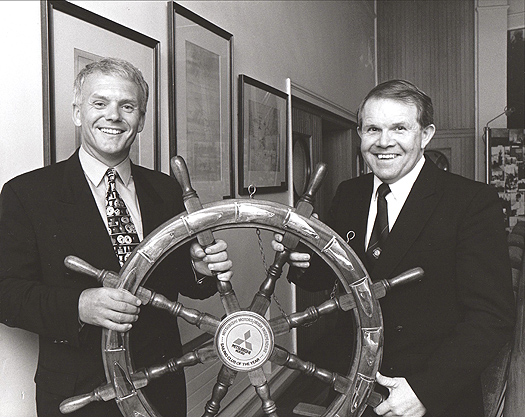
1995 was Howth YC's Centenary, which was brilliantly celebrated to make them Club of the Year. With the ship's wheel are Eugene O'Reilly of Mitsubishi Motors, and HYC Commodore David Lovegrove
For the first six years, the competition was restricted to clubs on the Leinster east coast, as that was the area covered (in every sense) by the coal company. But in the mid-1980s Frank Keane, that extraordinary bundle of energy and innovation in the motor business, decided that he needed to balance his extremely successful BMW distributorship with a Japanese model aimed at a different segment of the market. So he took on Mitsubishi Motors just as they were launching vehicles which might have been made for Irish roads such as the Pajero. As he was another of Sean O'Shea's clients, in very quick order the Club of the Year award acquired an excellent and enthusiastic sponsor, and it went national.
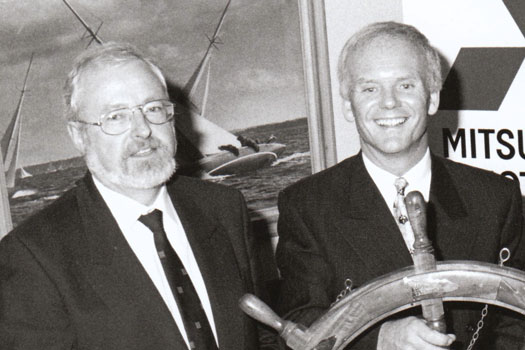
To honour a remarkably successful season achieved in 1997, Kinsale YC were Club of the Year for 1998. Commodore Pat Pyne accepts the trophy from Eugene O'Reilly.
Becoming an all-Ireland thing with 120 clubs under consideration was a quantum leap, but when you find yourself being encouraged by the top people in the motor business, you're in a different league. They're as tough as old boots, yet utterly human and thoughtful underneath it all. It's difficult to tell sometimes if it's delight in business or shared joy in good cars which motivates them, but it was an eye-opener for the rest of us as the Club of the Year trophy went to all parts of Ireland.
In every corner of the country, however remote, Frank Keane would have as a guest some old customer who'd bought one of the very first BMWs from him many years earlier, and had bought several ever since, some of them on an annual basis not because the cars wore out, but because he was such a pleasure to do business with.
But it was a while before we settled into this successful pattern, and for the first year with Mitsubishi Motors, the ceremony was in the Dublin area in any case, with Howth YC being the 1986 winners, neatly timed as the awards ceremony was one of the first events in their startling new clubhouse in April 1987.

Kinsale sailors with their trophy in April 1998. Front row includes KYC Commodore Pat Pyne (left), Eugene O'Reilly (centre) and John Twomey, now President of International Federation for Disabled Sailing (right), while on the right in the back row are international yacht designer Ron Holland, and Figaro skipper Damian Foxall, who sailed under the Kinsale burgee.
But through 1987, one club was to be head and shoulders above all others. The Royal Cork, oldest yacht club in the world dating from 1720, was on one of its frequent sprints, achieving in all areas. Yet around that time, yachting historian Hal Sisk was voicing his reservations about Royal Cork being the world's most senior club, pointing out that it was absolutely definite that an organisation called the Squadron of the Neva had been established in Russia by Czar Peter the Great in St Petersburg in 1718 with the express purpose of encouraging the sons of the aristocracy to take up recreational boating.
It was an interesting point, and it had to be addressed. So when at year's end the Royal Cork were announced as the Club of the Year (and they've now won it five times in all), somehow a crazy idea arose. We wouldn't go all the way down to Crosshaven to present them with the trophy. At the best of times, it was a tricky proposition for Mitsubishi Motors and the Irish Independent alike, as it would have taken us into the heart of Ford territory and Cork Examiner land. But instead, we'd see if we couldn't arrange to have the presentation in the Russian Embassy in order to acknowledge our awareness of the claims of the Squadron of the Neva, while highlighting the magnificent achievements in 1987 by the Royal Cork YC.
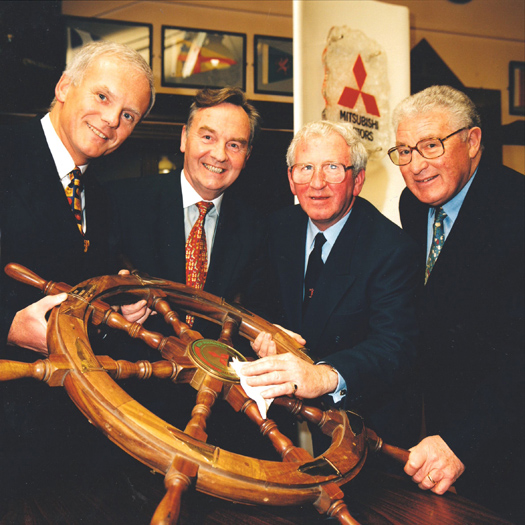
1998 saw the Tall Ships visit Dublin in large numbers, and volunteers from all over Ireland converged on the port to assist in the massive logistics support operation afloat in the harbour. Poolbeg Yacht & Boat Club in Ringsend was the focal point for his superb exercise in co-operation, and it was celebrated by PY&BC becoming Club of the Year for 1999. At the award ceremony are (left to right) Eugene O'Reilly (MD Mitsubishi Motors), Minister for the Marine Dr Michael Woods TD, James O'Donnell (Commodore, PY & BC) and Frank Keane (Chairman, Mitsubishi Motors).
This was to be done in the early Spring of 1988. It was a tricky proposition. Although Perestroika and Glasnost were becoming evident, the Berlin Wall wasn't to fall until 1989. The Soviet Union may have been creaking and rattling more than somewhat, but the fine house in Dublin's elite ambassadorial belt was still very much the embassy of the USSR – the Union of Soviet Socialist Republics. Calling it the Russian Embassy was getting ahead of the game. This was the eastern bloc's headquarters in Dublin, with the Cold War still very much with us, and no mistake.
Yet they agreed to host the party. So now we'd equally tricky negotiations. Would the Royal Cork YC agree to come to Dublin on such a bizarre mission? God bless them, they came in force. We had the makings of the most unusual party ever staged in Irish sailing.
Our host was the Soviet ambassador himself. If in the 1980s you'd asked for Central Casting to send you an actor to personify the popular conception of a Soviet diplomat, they'd have sent you Gennady Uranov. Though he was qualified as an engineer, in the continuous turmoil and unexpected outcomes of Russian and Soviet history, somehow he'd ended up in the diplomatic service and done comfortably well, as the embassy in Ireland was a very agreeable posting. Fairly heavily built but in trim shape, with well-tamed strong grey hair, the ambassador had presence, with charm and an occasional sense of humour. Nevertheless he was very much on his guard, as this was an unusual event, indeed an unprecedented one, and with turmoil back home the embassy people weren't a hundred per cent certain, for all that they'd got approval from headquarters as to how their actions would be interpreted back in Moscow, let alone who would be doing the interpreting.
Meanwhile, we'd our own little drama to play out. As part of the evening's programme, Hal Sisk outlined in detail the Squadron of the Neva's claims to seniority. It has to be admitted that the faces of the Royal Cork group were not those of happy budgies. Nevertheless they manned up and accepted the ship's wheel trophy with good grace, pleasantries were exchanged between all parties with the ambassador being a sort of amiable Russian bear in the midst of it all, and then I'd to deliver the adjudicators' reasons for the Royal Cork being the Club of the Year.
It was soon done, but the moment was too good to miss. As we'd everyone relevant there, the opportunity to blow the Squadron of the Neva's claims of seniority clear out of the water was taken with enthusiasm. The point was made that the Water Club of the Harbour of Cork established precedents for what a sailing club should be, right from the very start. The first Admiral may have been Lord Inchiquin of Rostellan Castle on Cork Harbour, but his fellow members, while they may have been rich – very rich by Irish standards – were "commoners", joined together in a self-starting society of mutual support and agreement in order to express a shared interest and pleasure in sailing, and adhering to a collection of self-generated club rules which were so effective that many of them are still relevant today, with the rules of Water Club having a contemporary feel despite the fact that they were codified by equals back in the middle of the 17th Century.
The Squadron of the Neva, on the contrary, wasn't a club at all. It was a small unit of the Imperial Russian Navy, imposed by the diktat of an omnipotent Czar who wanted to make his governing classes more sea-minded. There is simply no comparison with the Water Club, which has provided the template for democratic sailing clubs ever since. But the rigid structure of the Russian organisation was something else altogether, and is only of relevance in how to organise a navy, or more accurately – judging by the outcome of the Russian-Japanese War of 1904 – how not to organise a navy.
That historical point having been clarified to the approval of the Royal Cork, the Mitsubishi Motors "Sailing Club of the Year" took off at national level, and when the Royal Cork won it again in 1992, there was no hesitation in venturing into the Indian territory of Fordland and Cork Examiner country for the award ceremony, with the Crosshaven clubhouse's flagpole dressed overall in April 1993 for a monumental party.
Anthony O'Leary had just been elected Admiral, but his predecessor in 1991 and 1992 had been Kevin Lane, whose acceptance speech was distinctly thought-provoking for those of us who might have been treating the Club of the Year business in a light-hearted way. Kevin Lane spoke briefly but forcefully. He said quite clearly that when he became Admiral in advance of the 1991 season, he called his top sub-committee chairmen together, and told them that that the underlying thread of his two years in office would be to fulfil a programme afloat and ashore so through and enthusiastic that there would be no doubt by the Autumn of 1992 that Royal Cork was going to be the new Club of the Year.
The adjudication panel were astonished and silenced for a little while, for we'd known nothing of the Admiral's mission statement in 1991. This was awesome stuff. But with the Royal Cork setting the standard in 1992, and having set the standards back in 1720, the ship's wheel trophy was now part of Irish sailing heritage, and so it has remained ever since, with tonight's announcement being followed in due course by a handover ceremony at the winning club as the new season gets under way.
But as we get this glimpse of the future, spare a thought for those who were there in the Soviet Embassy back in 1988. One outcome was that an unlikely friendship was struck up between Eugene O'Reilly, Financial Controller and later MD of Mitsubishi Motors Ireland, and Ambassador Gennady Uranov. It became more than an exchange of pleasantries and letters. Eugene and his family went to stay with Gennady and his family in Russia, and holidayed with them. The Irishman was disconcerted to find that, in addition to his diplomatic role, his host was a Colonel in the Russian secret service, the KGB. Not to worry, said Gennady, everyone who's anyone in Russia is a Colonel in the KGB – it's like a sort of combination of the Freemasons and the Knights of Columbanus.
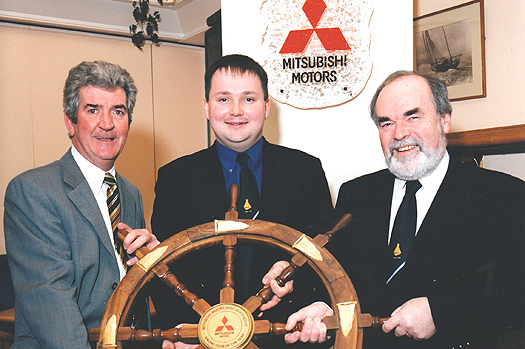
With the new Millennium, the competition was expanded to include Class Associations, and subsequent winners have included the Shannon One Design Association. In 2001, the winner was Ireland's (and the world's) oldest One Design keelboat class, the Howth 17s, established 1898. The trophy was presented to incoming Class Captain Marcus Lynch (centre) by Paddy Murphy (left), Marketing Manager, Mitsubishi Motors, with Frank Cruise, outgoing Captain Howth 17 Class Association.
Alas, whichever branch of this secretive organisation he was in, the former ambassador to Ireland proved to be on the wrong side of the rapidly-changing new developments in Russia. He was dropped from the diplomatic service, and sent to the salt mines. That's not quite as dreadful as it sounds. With his qualifications, he became a senior engineer in Russia's vast salt mines. Many would have regarded it as a plum job. But for someone who'd fitted comfortably into life on the Dublin diplomatic circuit and had quietly relished hosting the occasional unusual party for sailing weirdos who used his hospitality to dispute obscure points of history, it must have been grim.
And who knows, but perhaps something which came out of Gennady Uranov's introduction to the Irish sailing community may have hastened his downfall. For he was so taken with it all that he arranged for his two sons to be enlisted in the Royal St George Yacht Club junior training programme in Dun Laoghaire. Quite what the founders of the George – Anglican Ascendancy establishment figures to a man – would have made of their successors accommodating the children of the senior agent in Ireland of Godless atheistic communism heaven only knows, yet it happened.
So perhaps his downfall came about because someone in the Kremlin spotted a celebrated headline which was splashed across an Irish tabloid when an ace reporter discovered that the Russian ambassador's sons were going yachting.
RED SONS IN THE SAIL SET, it said. It may have delighted Dublin journalists, not least in that the song Red Sails in the Sunset was written by Irishman Jimmy Kennedy. But it can't have pleased the heirs of old Joe Stalin.
Kinsale Yacht Club Wins Club of the Year Award
#cluboftheyear – Kinsale Yacht Club have been confirmed as the Mitsubishi Motors "Sailing Club of the Year" for 2014 in celebration of an outstanding year during 2013, in which Commodore Cameron Good led his enthusiastic membership through a busy programme of activities, innovations and improvements. There was top sailing achievement afloat, too, both in hosting a remarkable series of major events – regional, national and international – and in the members' own winning of trophies afloat.
In the pretty south coast sailing and fishing port of Kinsale, KYC is one of the major focal points in the town. It interacts vigorously with its community, while at the national and international level, it has set the pace in communication and image projection through an excellent upgrade of its website, which saw it being the winner of the Afloat.ie Club Website award.
Domestically, the club initiated a major upgrade of its harbourside premises which was project-managed with exceptional skill – the builders moved in at the beginning of March, and the job was completed on time in late June ready for Kinsale YC's hosting of its biennial major regatta, the Sovereign's Trophy.
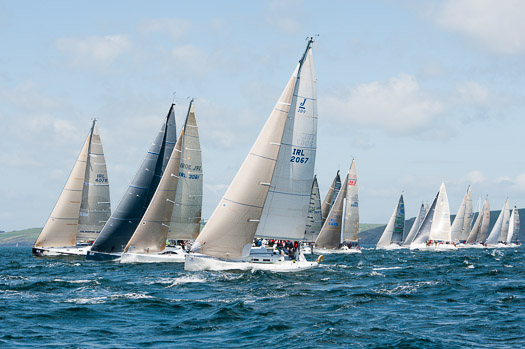
Racing for the Sovereigns Trophy 2013, with Kinsale YC organising the event, their own boats getting into the frame, and the superbly re-vamped clubhouse waiting to welcome everyone back to shore. Photo: Bob Bateman
Very deservedly, the KYC team got the weather they needed to make the Sovereigns one of the highlights of the Irish sailing year, with strong sunshine and fine sailing breezes ushering in the proper summer after the unsettled weather of June.
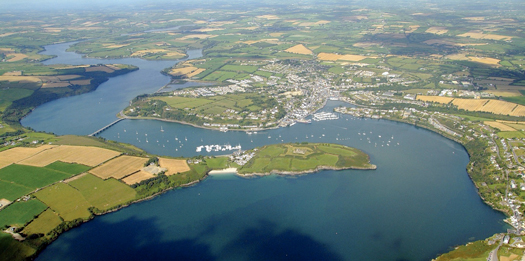
(Above and below) Kinsale Yacht Club's sailing waters and the race area for both the IFDS worlds and Sovereign's Cup in 2013. Photo: Bob Bateman
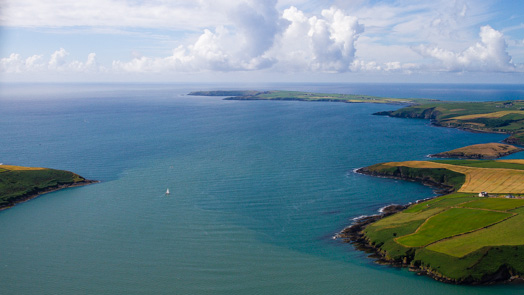
One of the great strengths of Kinsale sailing is that, in addition to cheerfully fulfilling their hospitality duties in having a popular marina which is the key port for hundreds of cruising boats coming to Ireland every year, plus the club's ready ability to provide a top class race management team when visiting classes request it, the club also has its own very active local racing fleet. There's a strong out-turn of cruisers augmented by a growing fleet of the Squibs which have proven to be ideal for Kinsale's needs, while the keen fleet of Lasers is another part of the Kinsale fabric, balanced in turn by the heritage represented by the International Dragons in which, over many years, Kinsale has sent forth teams to win at global level.
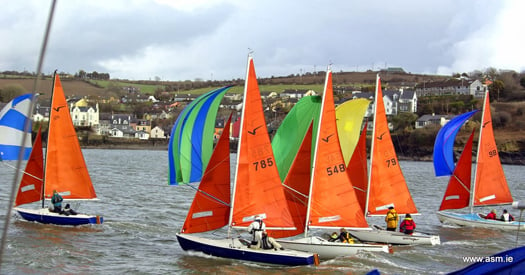
A sailing club's achievement would be hollow if it only hosted major events. Kinsale's strength is under-pinned by its strong inshore racing classes, with the Squibs – seen here racing in the current early-season series – developing into one of the strongest fleets in the country. Photo: Aidan McLaverty
The club also plays an active role in providing talented administrators for national and international sailing bodies. David Tucker of Kinsale completed his tour of duty as Commodore of the Irish Cruising Club just last month, while KYC's former commodore John Twomey was elected President of the International Federation for Disabled Sailing in November 2012, a position he continues to fill with energy, enthusiasm, and a great ability to get things done.
Thus it was John Twomey's unrivalled prestige in the international world of disabled sailing that saw Kinsale hosting the highlight of its 2013 season, the IFDS Worlds in August. This was a very major event, an exceptionally international series in which the large fleet required the dedicated effort of something like 120 volunteers drawn from the KYC membership, while the club spread its community involvement beyond the confines of the town by bringing in Cork County Council as the main sponsor.
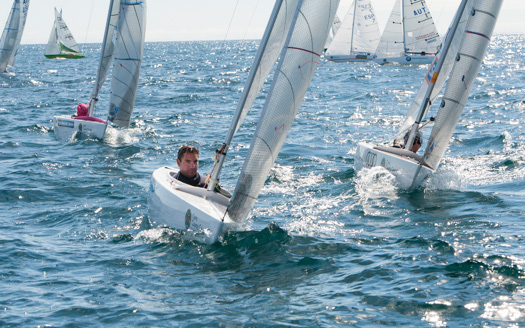
Summertime off Kinsale. KYC's staging of the IFDS Worlds in August 2013, with Cork County Council the main sponsors, achieved global recognition and was one of the highlights of the Irish season in 2013. Photo: Bob Bateman.
The outcome was a hugely successful event in which a genuine dynamic interaction between land and sea was played out every day. And it was all of a piece with KYC's very positive attitude to its role in sailing, in its own town, in Cork County, and in Ireland and the world. Kinsale Yacht Club is indisputably Ireland's Mitsubishi Motors "Sailing Club of the Year" for 2014.
#cluboftheyear – Royal St George Yacht Club in Dun Laoghaire are the 2013 Mitsubishi Motors "Sailing Club of the Year" in celebration of an outstanding twelve months of success.
The famous ship's wheel trophy, which has played a central symbolic role in Irish sailing since 1979, was presented to Martin Byrne, Commodore of the Royal St George YC, in Dun Laoghaire last night at the ISA Ball by Guest of Honour Tanaiste Eamon Gilmore TD, and Brian Keane of Mitsubishi Motors.
In all, four clubs made the final shortlist – in alphabetical order in addition to the RStGYC they were Baltimore Sailing Club (home club to both the national senior and junior champions, and host club to a rapidly expanding training programme), University College Dublin SC (Student World Sailing Champions), and Wicklow SC, whose biennial Round Ireland Race is now an integral part of the international programme, with a thriving and dynamic interaction between club and town building on the success of the event.
Faced with other clubs achieving at this level, it says everything for the performance of the Royal St George YC that it has won the trophy. But the adjudicators' conclusions – carried in full below - explain why the trophy will now be on display on the walls of a club which has been in the sailing business since 1838.
"Royal St George YC – In many clubs, the staging of an event of the significance of the ISAF Youth Worlds in Dublin Bay in July 2012 would lead to an imbalance in club functioning lasting for several months. It speaks volumes for the sheer strength of the RStGYC "machine" that it undertook this mega-regatta, yet at the same time continued successfully to meet the needs of its ordinary members, whether in sailing or in providing excellent club facilities of all kinds.
With its large active sailing membership, the club made its mark with sailing success in many areas, its efforts spear-headed by Commodore Martin Byrne, who led by example – he emerged as the top Irish International Dragon Sailor of 2012. The club is also something of a pace-setter in recruiting sailing talent among young people re-locating to Dublin, and in 2012 it reached new heights in this area with its very active support of UCDSC as it set in place its successful campaign towards winning the Student Yachting Worlds in France in October.
Such activities were all in addition to the prodigious effort, energy and enthusiasm which was put into the Youth Worlds, and the buildup to it, which began in Dublin Bay in April. The ultimate success of the regatta was highly praised by outgoing ISAF President Goran Petersson at the ISAF Conference in Dun Laoghaire in November. But perhaps most impressive is the goodwill and co-operation which the RStGYC generated in the local community and among the very many volunteers from several clubs, who gave freely of their time to make this event such a success, and who afterwards were more than happy with the way the RStGYC appreciated their efforts and the quality of their input into a great event.
In achieving so many objectives both afloat and ashore, while at the same time meeting the needs of its many members and maintaining a mutually beneficial and vibrant relationship with the community both locally and nationally, the Royal St George Yacht Club has fulfilled the criteria for the Sailing Club of the Year in exemplary style".
Royal St. George is Club of the Year
The assessors in the Mitsubishi Motors/Irish Independent "Sailing Club of the Year 2010" adjudication have placed a strong emphasis on national and international sailing success in analysing the overall achievements of the past year.
Little wonder, then, that the Royal St George Yacht Club in Dun Laoghaire took the gong this year. Commodore Patrick Blaney has led its large and energetic membership through a cracker of a year since he took over the top post in March 2009. In fact, success in the new year has already been logged with long-time member Adrian Lee winning overall with his Cookson 50 in the new international offshore classic, the RORC Caribbean 600 in February.
Then the club's team racing ace, John Sheehy, began to slice through the developing Irish match-racing scene, winning the first regional event at Dromineer in April, and taking the national title at Kinsale in October. Meanwhile the Irish offshore season was getting under way, and though the popular biennial 266-mile Dun Laoghaire to Dingle Race is run by the neighbouring National YC, the Royal St George made hay in the record fleet, with Mick Cotter's 78ft Whisper taking line honours and setting a new course record, while Cathal Drohan and Paul Egan's X41 Legally Blonde won overall on corrected time.
The club has a very active junior section, and it was rewarded by international success in 2009, with Matty O'Dowd taking the Laser Radial Europe Cup in Denmark, and the Irish Nationals on Lough Derg. Back home, the RStGYC was at the heart of the hectic four day Volvo Dun Laoghaire Regatta in July, and member Flor O'Driscoll took the top title with his superbly crewed J/24.
August saw Mick Cotter's Whisper in action again, placing best of all Irish boats in the Fastnet Race, a fifth overall in the huge fleet, putting her ahead of many racing machines, and first of the cruiser-racers, a placing she repeated at the Maxi Worlds in Sardinia in September. At home during August, the club hosted the Optimist Irish Nationals, the largest one design event in Ireland in 2009 with 243 junior helms racing in demanding conditions, doubly useful as Royal St George will be staging the World Youth Sailing Championships in 2012.

(l to r) Frank A. Keane (Mitsubishi Motors Ireland) & Commodore Patrick Blaney (RStGYC)
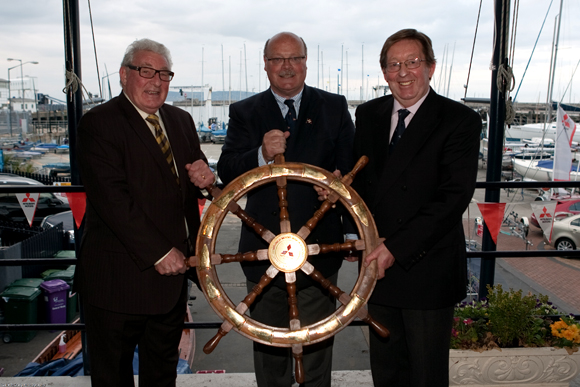
(l to r) Frank A. Keane (Mitsubishi Motors Ireland), Commodore Patrick Blaney (RStGYC) & Winkie Nixon (Irish Independent / Afloat Magazine)




























